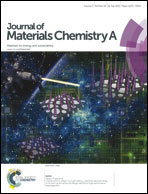Thermo-processable covalent scaffolds with reticular hierarchical porosity and their high efficiency capture of carbon dioxide†
Abstract
The preparation of moldable porous organic scaffolds with a hierarchical pore structure is demonstrated. The study shows for the first time that molecularly cross-linked covalent networks can be molded into a desired shape with three-dimensionally interconnected pores ranging over multiple length scales. Thermal cleavage and rearrangement chemistry of urea bonds allows the network to generate subnanometer pores with their nanoparticles being sintered to a monolithic structure containing pores of 2 to 100 nm via inter-particle sintering. Selective expulsion of small molecular fragments during the thermolysis of the network generated reticular micropores. The resultant hierarchically porous objects exhibited excellent capacity and selectivity for adsorption of carbon dioxide even from low concentration sources, for example, from the gas mixture of typical indoor air quality. The soft covalent network approach used here gives insights into the development of covalent organic networks with pore-based functionalities.


 Please wait while we load your content...
Please wait while we load your content...